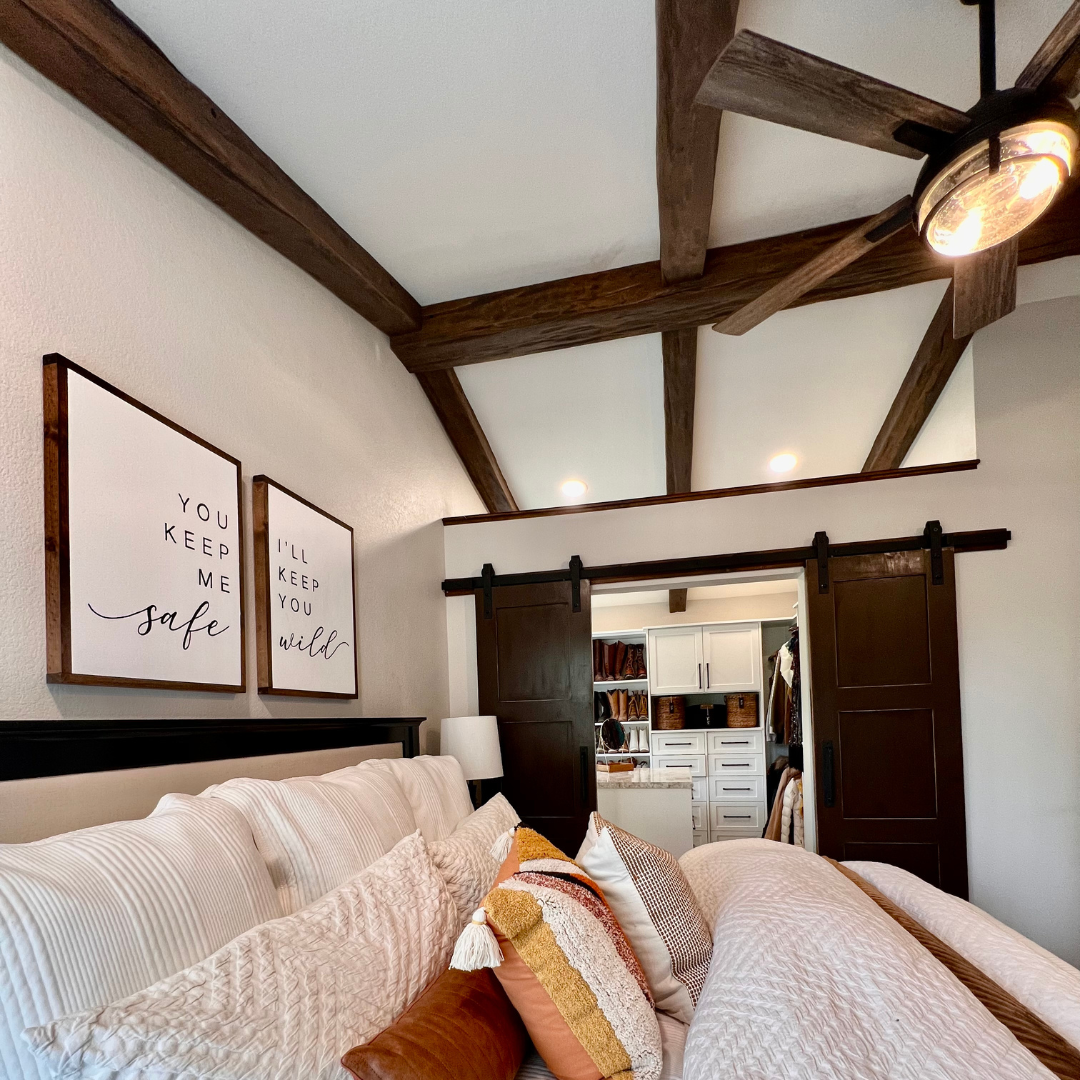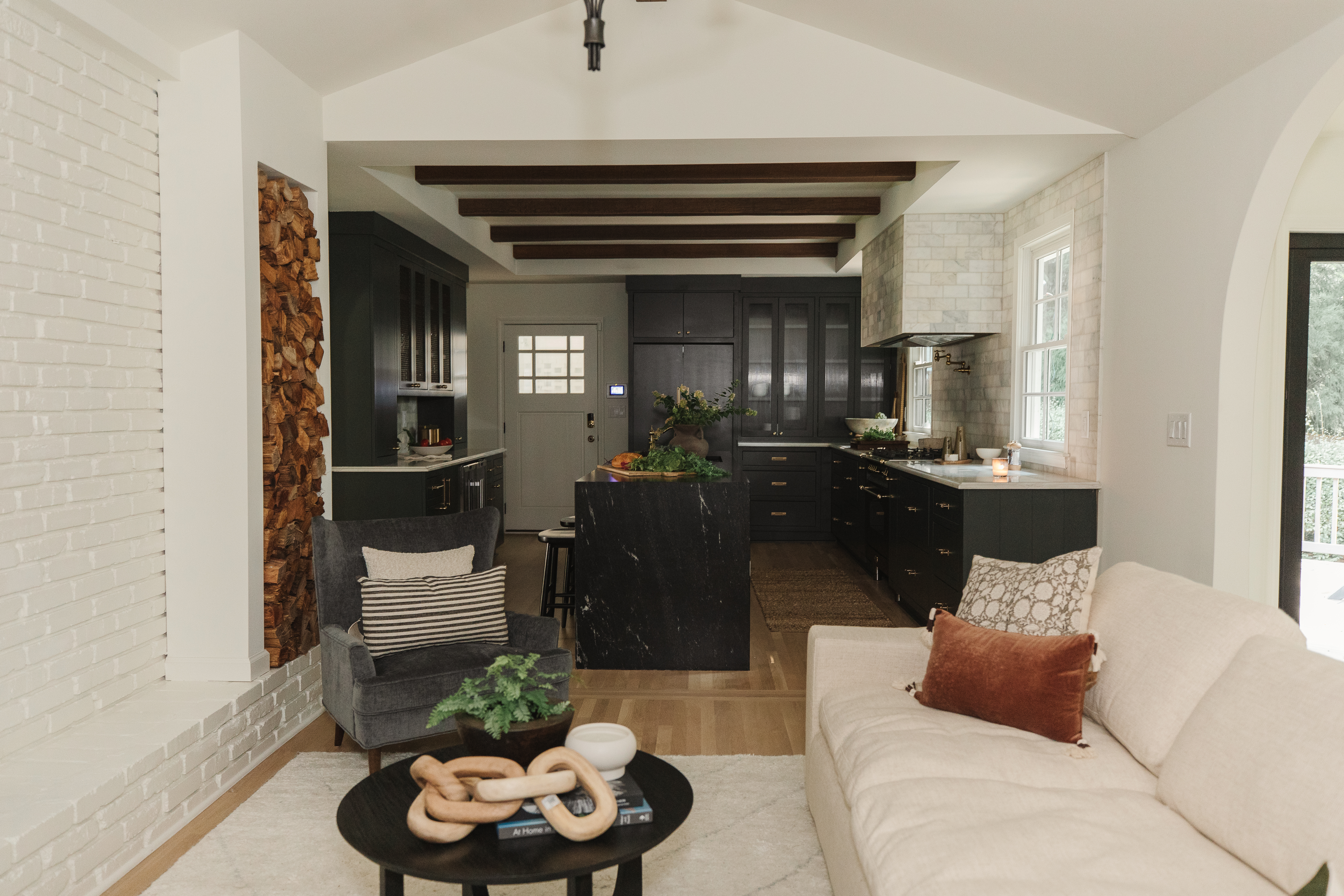
Nothing makes a bigger statement than a gorgeous wood beam running across the ceiling of a room. The wood grains, dynamic texture, and warmth of wood ceiling beams take any room to another level.
Solid wood beams, however, can be expensive to purchase and maintenance can be time-consuming. Because solid wood beams are heavy and difficult to manage on your own, you will likely have to hire a contractor to install them, adding another expense to your project.
Our collection of box wood beams is perfect for homeowners who don’t have the budget, the skills, or the time to install solid wood beams. Faux wood ceiling beams are carefully crafted to mimic the look and feel of real wood and can be customized to suit any style. The light weight of faux wood beams makes installation an easy, DIY project.
Don’t believe it? Keep reading for an overview of how to install faux wood beams.
Before You Get Started
Before you begin installing your beams, it's important to ensure your surface is structurally sound and in good condition. The drywall should be flat and smooth to minimize gaps. If any part of your installation surface needs to be fixed, get that done before you install.
Next, gather the following tools and materials:
- Caulk Gun
- Chalk Line/Laser
- Clean Cloth
- Color Complimenting Textured Caulk
- Deck Screws
- Hand Saw with Finish Blade
- Ladder
- Painters Tape
- Pencil
- Loctite PL Premium 3X Construction Adhesive
- Safety Glasses
- Screw Gun/Drill Driver and Bits
- Small Paint Brush
- Square/T-Bevel
- Stud Finder
- Tack Cloth
- Tape Measure
- Toggle/Lag Bolts
- Touchup Kit
- Wood Beams
- Wood Blocking (2x4” or 2x6”)
- Wood Cutting Saw with Finish Blade
How to Install Faux Wood Beams Step-by-Step

- Below is an overview of how to install faux wood beams. When you’re ready to get started, follow our detailed installation instructions with diagrams, and watch our helpful installation video.
Step 1. Lay Out the Installation
This is where you map out your beam design including how far apart to space your beams, and in which direction you want them to run. Once you have your beam design mapped out, mark your guidelines with painter's tape or a chalk line.
Step 2. Locate Studs and Mark Them
Using a stud finder, locate the studs and mark them with a pencil. If the studs don’t line up with the installation, you’ll need to use toggle/lag bolts to attach your mounting blocks. Mark all studs using a stud finder and pencil.
Step 3. Determine How Many Mounting Blocks You Need
To calculate how many mounting blocks you need, use the formula A+B+C.
- 1 block at each end of the beam (2 blocks)
- 1 block at least every 3 feet of the beam
- 1 block used at the joint where beams meet if you’re using more than one beam in a run
Step 4. Measure and Cut Your Mounting Blocks
Grab your ceiling beam and measure the inside dimensions, then subtract ⅛ inch to determine the size of the mounting blocks.
Then, cut the quantity of mounting blocks you calculated in step 3 and pre-drill at least two holes per block to make them easier to attach.
Step 5. Attach Mounting Blocks to Ceiling
Attach the first mounting block as close to the side wall as possible and in line with the guides you drew in step 1.
Then, secure additional mounting blocks to the ceiling at 3-foot intervals using screws into studs or toggle/lag bolts into drywall. Be sure to place a block where the beams meet if you’re using more than one beam in a run.
Mark the location of the mounting blocks by placing painter's tape about 1½ inches from each side of the blocks. This will be helpful for step 8.
Step 6. Dry Fit
Check your beam length by dry-fitting it in place. Trim if needed.
Step 7. Apply Adhesive
Wipe the edges of the mounting blocks and the inside of the beam to remove dust and debris.
Then apply adhesive to the edges of the mounting blocks that will contact the beam.
Step 8. Install Beam
Slide your beam in place over the mounting blocks.
Slightly countersink a minimum of two screws per side, through the beam at each mounting block. This holds the beam in place until the adhesive dries.
Wipe off any visible adhesive using a clean cloth.
Step 9. Touch Up
Apply color-complimenting textured caulk to fill screw holes, then blend caulk into adjacent surfaces while it is still wet.
If necessary, apply caulk to joints and gaps. Use paint from your touch-up kit to paint over the caulk.
And, that’s it! In just nine simple steps, and the help of one other set of hands, you can install faux wood beams in just a few hours.
Faux Wood Beam Installation Considerations

Faux wood ceiling beams are hollow, giving them another edge over real, solid wood beams.
For example, hollow beams can be used to cover unsightly ductwork, pipes, and structural elements like steel beams. Before you install your faux beams, be sure to consider if these scenarios apply to your project.
Do you plan to install recessed lighting into your ceiling beam?
You don’t have to sacrifice light to enjoy the transforming benefits of faux wood beams! Discover how you can install recessed lighting into your beams.
Do you want your beams to cover ductwork?
The hollow design of faux wood beams can beautifully hide ductwork. If this is in your plans, use our easy ducts and vents in beams installation guide.
Do you want to hang a ceiling fan or chandelier from a beam?
If you plan to hang a ceiling fan or chandelier from a beam, use the chandelier and ceiling fan installation instructions as a supplement to the beam installation instructions.
Are you installing on a cathedral ceiling?
To attach a beam to a cathedral ceiling, you have to find the highest point of the ceiling – the apex. Then, use screws long enough to go through the mounting block and into the studs. Use our instructions for mounting a ridge beam if you have a cathedral ceiling.
Is your beam under 10 feet long?
Installing faux wood beams that are under 10 feet long is a little different. Be sure to follow these installation guidelines if your beams fit this length.
How to Choose the Right Faux Wood Beam
Faux wood beams have several clear advantages over solid wood beams. And by now you should know that you don’t have to sacrifice looks and style for an affordable, easy-to-install product!
AZ Faux offers a wide variety of faux wood beams, including nine basic beams, eight arched beams, and custom truss designs. No matter which style you choose, you’re getting a beam that’s budget-friendly and beautifully mimics real wood with no maintenance required.
And, with installation this simple, you can transform the look of a room in a matter of hours.
Ready to add some character to your home?